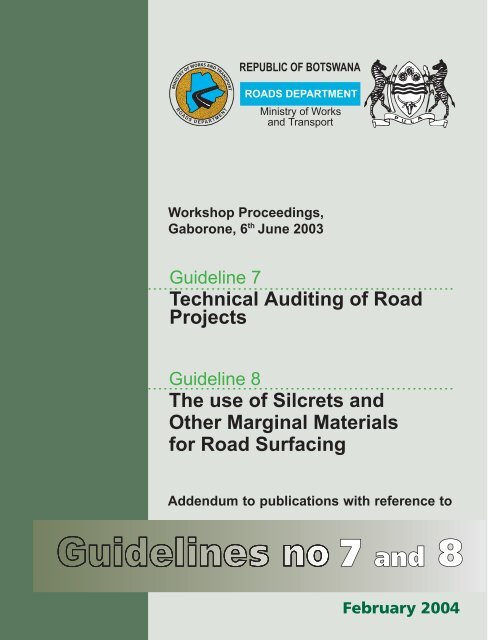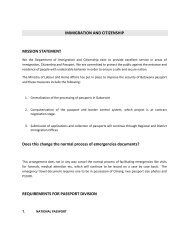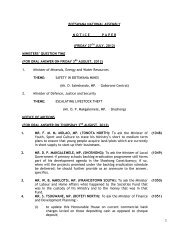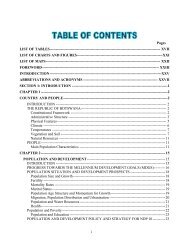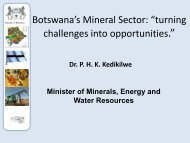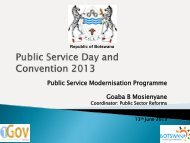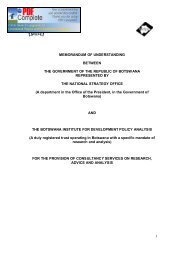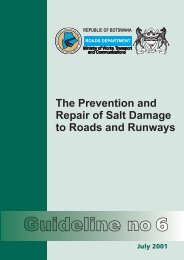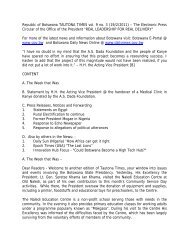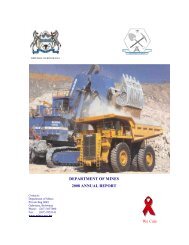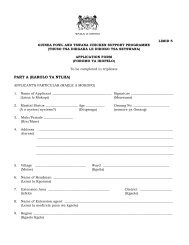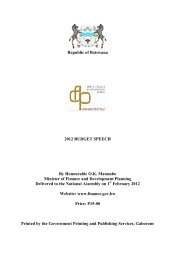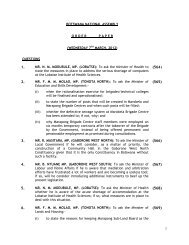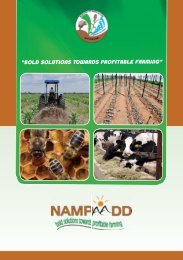7 and 8 - Government of Botswana
7 and 8 - Government of Botswana
7 and 8 - Government of Botswana
Create successful ePaper yourself
Turn your PDF publications into a flip-book with our unique Google optimized e-Paper software.
MINISTRY OF WORKS AND TRANSPORT<br />
Ministry <strong>of</strong> Works<br />
<strong>and</strong> Transport<br />
Workshop Proceedings,<br />
Gaborone, 6 th June 2003<br />
Guideline 7<br />
Technical Auditing <strong>of</strong> Road<br />
Projects<br />
Guideline 8<br />
The use <strong>of</strong> Silcrets <strong>and</strong><br />
Other Marginal Materials<br />
for Road Surfacing<br />
Addendum to publications with reference to<br />
7 an<br />
<strong>and</strong> 8<br />
February 2004
Workshop Proceedings,<br />
Gaborone, 6 th June 2003<br />
Guideline 7<br />
Technical Auditing <strong>of</strong> Road<br />
Projects<br />
Guideline 8<br />
The use <strong>of</strong> Silcrets <strong>and</strong> Other<br />
Marginal Materials for Road<br />
Surfacing<br />
Proceedings <strong>of</strong> Roads Department Workshop June 2003, Guidelines 7 <strong>and</strong> 8 1
Ministry <strong>of</strong> Works <strong>and</strong> Transport<br />
Roads Department<br />
Private Bag 0026<br />
Gaborone,<strong>Botswana</strong><br />
Phone +267 -393511<br />
Fax +267 -394278<br />
February 2004<br />
Addendum to publications with reference to<br />
Guideline no 7: Technical Auditing <strong>of</strong> Road Projects<br />
ISBN 99912 - 0 - 317 - 6<br />
Guideline no 8: The use <strong>of</strong> Silcrete <strong>and</strong> Other Marginal Materials for Road Surfacing<br />
ISBN 99912 - 0 - 381 - 8<br />
Reproduction <strong>of</strong> extracts from this Guideline may be made subject to due acknowledgement <strong>of</strong> the source.<br />
Although this Guideline is believed to be correct at the time <strong>of</strong> printing, Roads Department does not accept<br />
any contractual, tortious or other form <strong>of</strong> liability for its contents or for any consequences arising from its use.<br />
Anyone using the information contained in the Guideline should apply their own skill <strong>and</strong> judgement to the<br />
particular issue under consideration.<br />
2<br />
Proceedings <strong>of</strong> Roads Department Workshop June 2003, Guidelines 7 <strong>and</strong> 8
ROADS DEPARTMENT<br />
Under the policy direction <strong>of</strong> the Ministry <strong>of</strong> Works, Transport & Communications, Roads Department is responsible for providing<br />
an adequate, safe, cost-effective <strong>and</strong> effi cient road infrastructure within the borders <strong>of</strong> <strong>Botswana</strong> as well as for facilitating cross border<br />
road communications with neighbouring countries. Implied in these far-ranging responsibilities is the obligation to:<br />
1. Ensure that existing roads are adequately maintained in order to provide appropriate level <strong>of</strong> service for road users.<br />
2. Improve existing roads to required st<strong>and</strong>ards to enable them to carry prevailing levels <strong>of</strong> traffi c with the required degree<br />
<strong>of</strong> safety.<br />
3. Provide new roads to the required geometric, pavement design <strong>and</strong> safety st<strong>and</strong>ards.<br />
The Department has been vested with the strategic responsibility for overall management <strong>of</strong> the Public Highway Network (PHN) <strong>of</strong><br />
some 18,300 km <strong>of</strong> roads. This confers authority for setting <strong>of</strong> national specifi cations <strong>and</strong> st<strong>and</strong>ards <strong>and</strong> sheared responsibility with<br />
the District Councils <strong>and</strong> Department <strong>of</strong> Wildlife <strong>and</strong> National Parks for the co-ordinated planning <strong>of</strong> the PHN.<br />
Roads Department is also responsible for administering the relevant sections <strong>of</strong> the Public Roads Act, assisting local road authorities<br />
on technical matters <strong>and</strong> providing assistance in the national effort to promote citizen contractors in the road construction industry<br />
by giving technical advice wherever possible. This task is facilitated by the publication <strong>of</strong> a series <strong>of</strong> Technical Guidelines dealing<br />
with st<strong>and</strong>ards, general procedures <strong>and</strong> best practice on a variety <strong>of</strong> aspects <strong>of</strong> the planning, design, construction <strong>and</strong> maintenance<br />
<strong>of</strong> roads in <strong>Botswana</strong> that take full account <strong>of</strong> local conditions.<br />
� Guideline No. 1: The Design, Construction <strong>and</strong> Maintenance <strong>of</strong> Otta Seal (June, 1999).<br />
Addendum to Guideline No. 1 – Seminar Proceedings (June, 2000).<br />
� Guideline No.2–Pavement Testing, Analysis <strong>and</strong> Interpretation <strong>of</strong> Test Data (May, 2000).<br />
Addendum to Guideline No. 2 – Seminar Proceedings (January, 2002).<br />
� Guideline No. 3 – Methods <strong>and</strong> Procedures for Prospecting for Road Construction Materials (December, 2000).<br />
Addendum to Guideline No. 3 – Seminar Proceedings (April, 2002).<br />
� Guideline No. 4 - Axle Load Surveys (December, 2000).<br />
Addendum to Guideline No. 4 – Seminar Proceedings (January, 2002).<br />
� Guideline No. 5 - Planning <strong>and</strong> Environmental Impact Assessment <strong>of</strong> Road Infrastructure (September, 2001).<br />
� Guideline No. 6 – The Prevention <strong>and</strong> Repair <strong>of</strong> Salt damage to Roads <strong>and</strong> Runways (September, 2001).<br />
Addendum to Guideline No. 6 – Seminar Proceedings (April, 2002).<br />
� Guideline No. 7 – Technical Auditing <strong>of</strong> Road Projects (December, 2001).<br />
Addendum to Guideline No. 7 – Seminar Proceedings (February, 2004).<br />
� Guideline No. 8 - The use <strong>of</strong> Silcrete <strong>and</strong> other Marginal Materials for Road Surfacing (August 2002).<br />
Addendum to Guideline No. 8 – Seminar Proceedings (February, 2004).<br />
Proceedings <strong>of</strong> Roads Department Workshop June 2003, Guidelines 7 <strong>and</strong> 8 3
FOREWORD<br />
Guideline no 7 Technical Auditing <strong>of</strong> Road Projects<br />
This guideline document on technical auditing <strong>of</strong> road projects is a step in the right direction towards ensuring that the road projects<br />
undertaken in <strong>Botswana</strong> are appropriately designed <strong>and</strong> constructed.<br />
Financial auditing <strong>of</strong> public funded projects are done but it is the technical audit which had not received any attention in the past.<br />
The need for producing a guideline on such an important aspect arose from the fact that very recently, some <strong>of</strong> the road projects<br />
implemented in the country have either failed pre - maturely <strong>and</strong>/or are in the process <strong>of</strong> showing distress ultimately leading to<br />
failure in the near future. The irony is that it has not been possible to portion accountability to parties involved in the contract. It<br />
is my hope that Roads authorities, administrators <strong>and</strong> organizations will start thinking about carrying out Technical Audit <strong>of</strong> road<br />
projects in order to ensure that the government <strong>and</strong> public in general get value for investment incurred.<br />
The guideline describes step by step procedures involved in a technical audit process <strong>and</strong> details the methodology required to conduct<br />
a technical audit. This guideline will certainly go a long way in implementing road projects in the right manner <strong>and</strong> introduce<br />
accountability on the part <strong>of</strong> all Stakeholders, the Client, Consultant or the Contractor.<br />
Gaborone<br />
December 2001<br />
Andrew Nkaro<br />
Director <strong>of</strong> Roads<br />
Roads Department<br />
Ministry <strong>of</strong> Works <strong>and</strong> Transport<br />
Guideline no 8 The use <strong>of</strong> Silcrete <strong>and</strong> Other Marginal Materials for Road Surfacing<br />
The scarcity <strong>of</strong> good quality stone, which could be used as road surfacing aggregate in some parts <strong>of</strong> <strong>Botswana</strong>, dictated the use <strong>of</strong><br />
stones, which marginally meet the conventional specifi cations.<br />
This Guideline on the use <strong>of</strong> Silcrete <strong>and</strong> Other Marginal Materials for Road Surfacing is a very useful document in that it captures<br />
the experiences gained, over a period <strong>of</strong> twenty years, towards utilizing marginal/inferior materials available in <strong>Botswana</strong> when<br />
constructing road surface treatments.<br />
Experience has shown that under appropriate circumstances the use <strong>of</strong> marginal stones in surface treatments has produced durable<br />
<strong>and</strong> cost effective seals, which performed adequately under traffi c <strong>and</strong> the harsh, semi arid climate that prevails in <strong>Botswana</strong>.<br />
The Guideline makes the experiences gained over the years readily available for consideration <strong>and</strong> will act as a practical reference for<br />
engineers <strong>and</strong> technicians involved in the road building industry in <strong>Botswana</strong>. The guideline deals specifi cally with the properties,<br />
applications <strong>and</strong> performance <strong>of</strong> marginal aggregates in surface treatments.<br />
It is my sincere hope that this guideline will be useful to the road building industry in <strong>Botswana</strong> <strong>and</strong> will assist in ensuring that,<br />
under appropriate circumstances, marginal materials will fi nd their optimal use in road surfacing without necessarily compromising<br />
on quality <strong>and</strong> performance <strong>of</strong> the surface treatment as well as assist practicing engineers in judicious selection <strong>of</strong> marginal aggregates<br />
towards their appropriate use in the construction <strong>and</strong> maintenance <strong>of</strong> surface treatments in the most cost – effective manner.<br />
Gaborone<br />
August 2002<br />
Andrew Nkaro<br />
Director <strong>of</strong> Roads<br />
Roads Department<br />
Ministry <strong>of</strong> Works <strong>and</strong> Transport<br />
4<br />
Proceedings <strong>of</strong> Roads Department Workshop June 2003, Guidelines 7 <strong>and</strong> 8
ACKNOWLEDGEMENTS<br />
The Workshop Proceedings held in Gaborone 6 th June 2003 is an Addendum to publications with reference to Guideline no 7 Technical<br />
Auditing <strong>of</strong> Road Projects <strong>and</strong> Guideline no 8 The use <strong>of</strong> Silcrete <strong>and</strong> other Marginal Materials for Road Surfacing.<br />
The production <strong>of</strong> these Guidelines is one is <strong>of</strong> a series that is being published under the Institutional Co-operation Agreement<br />
that exists between the Roads Department <strong>and</strong> the Norwegian Public Roads Administration (NPRA). This agreement falls under a<br />
NORAD Technical Assistance Programme to Roads Department which is co-funded by the Kingdom <strong>of</strong> Norway <strong>and</strong> the <strong>Government</strong><br />
<strong>of</strong> the Republic <strong>of</strong> <strong>Botswana</strong>.<br />
The various opinions <strong>and</strong> refl ections given in the Workshop by the participating delegates are highly appreciated <strong>and</strong> is presented<br />
in the workshop proceedings. The Workshop reporter was Mr. Michael I. Pinard, Infra Africa Consultants.<br />
The production <strong>of</strong> the Addendum has been a joint effort between the Roads Department <strong>and</strong> NPRA; its preparation was co-ordinated<br />
by Mr. Charles Overby <strong>of</strong> the NPRA.<br />
Proceedings <strong>of</strong> Roads Department Workshop June 2003, Guidelines 7 <strong>and</strong> 8 5
TABLE OF CONTENTS<br />
1. INTRODUCTION .......................................................................................................................................................................... 7<br />
1.1 Welcome <strong>and</strong> Opening ............................................................................................................................................................................ 7<br />
1.2 Seminar Programme .................................................................................................................................................................................. 8<br />
1.3 Attendance ................................................................................................................................................................................................... 8<br />
2 PRESENTATION OF GUIDELINE NO. 8 ............................................................................................................................. 9<br />
2.1 Overview .................................................................................................................................................................................................... 9<br />
2.2 Presentation <strong>of</strong> Key Aspects .................................................................................................................................................................... 9<br />
2.3 Matters Arising from Discussion .......................................................................................................................................................... 9<br />
2.3.1 General ........................................................................................................................................................................................... 9<br />
2.3.2 Scope <strong>and</strong> Use <strong>of</strong> Guideline ..................................................................................................................................................... 10<br />
2.3.3 Properties <strong>of</strong> Silcretes ............................................................................................................................................................... 10<br />
2.3.4 Surfacing Aggregate Specifi cations ....................................................................................................................................... 11<br />
3. PRESENTATION OF GUIDELINE NO. 7 ............................................................................................................................... 14<br />
3.1 Overview ................................................................................................................................................................................................. 14<br />
3.2 Presentation <strong>of</strong> Key Aspects ................................................................................................................................................................ 14<br />
3.3 Matters Arising from Discussion ...................................................................................................................................................... 14<br />
3.3.2 Responsibility for undertaking audits ................................................................................................................................... 16<br />
3.3.3 Potential problems <strong>of</strong> technical auditing ............................................................................................................................... 16<br />
4. SUMMARY AND CLOSURE ..................................................................................................................................................... 17<br />
4.1 Summary <strong>of</strong> Key Issues .......................................................................................................................................................................... 17<br />
4.1.1 Guideline No. 8 ......................................................................................................................................................................... 17<br />
4.1.2 Guideline No. 7 .......................................................................................................................................................................... 17<br />
4.2 Closing Remarks ...................................................................................................................................................................................... 18<br />
ANNEXES ............................................................................................................................................................................................... 19<br />
Annex 1 - Programme ........................................................................................................................................................................................ 20<br />
Annex 2 - Seminar Attendance List ................................................................................................................................................................ 21<br />
6<br />
Proceedings <strong>of</strong> Roads Department Workshop June 2003, Guidelines 7 <strong>and</strong> 8
1. INTRODUCTION<br />
1.1 Welcome <strong>and</strong> Opening<br />
The Chairperson, Mr. M. Segokgo, welcomed delegates to the Roads Department seminar on Technical Auditing <strong>of</strong> Road Projects<br />
(Guideline No. 7) <strong>and</strong> The Use <strong>of</strong> Silcrete <strong>and</strong> Other Marginal Materials for Road Surfacing (Guideline No. 8). He then outlined<br />
the programme for the day which included presentations by the authors <strong>of</strong> the two Guidelines <strong>and</strong> discussion periods in which<br />
feedback from the participants was expected as an important objective <strong>of</strong> the workshop.<br />
The seminar was opened by the Roads Department’s Principal Roads Engineer, Materials <strong>and</strong> Research Division,<br />
Mrs. N. Mpotokwane, on behalf <strong>of</strong> the Director <strong>of</strong> Roads, Mr. A. Nkaro who was unavoidably absent due to other pressing<br />
engagements.<br />
In her opening remarks, Mrs. Mpotokwane expressed her delight at the good turnout to the seminar by a cross-section <strong>of</strong> stakeholders<br />
- consultants, contractors, academics, testing institutions, pr<strong>of</strong>essional bodies <strong>and</strong> other organisations - who provide services<br />
<strong>of</strong> various kinds to the Roads Department <strong>and</strong>, as a result, have some form <strong>of</strong> pr<strong>of</strong>essional relationship with the department.<br />
The main points made in her speech are as follows:<br />
● Roads Department had embarked on preparing a series <strong>of</strong> Guidelines under the Institutional Cooperation Agreement between<br />
Roads Department <strong>and</strong> the Norwegian Public Roads Administration.<br />
● The main objective <strong>of</strong> the Guidelines was to document best practice <strong>and</strong> preserve local knowledge in a variety <strong>of</strong> aspects <strong>of</strong><br />
road planning, design, construction <strong>and</strong> maintenance that have evolved over many years in <strong>Botswana</strong>.<br />
● The following eight Guidelines had already been produced <strong>and</strong> are available to all stakeholders. These Guidelines are based<br />
on valuable experiences <strong>and</strong> knowledge gained by Roads Engineers in the country <strong>and</strong> incorporate current practices within<br />
<strong>Botswana</strong>, the SADC region <strong>and</strong> elsewhere in the world.<br />
■ Guideline No. 1 - The Design, Construction <strong>and</strong> Maintenance <strong>of</strong> Otta Seals (June, 1999).<br />
Addendum to Guideline No. 1 - Seminar Proceedings (June, 2000).<br />
■ Guideline No.2 - Pavement Testing, Analysis <strong>and</strong> Interpretation <strong>of</strong> Test Data (May, 2000).<br />
Addendum to Guideline No. 2 - Seminar Proceedings (January, 2002).<br />
■ Guideline No. 3 - Methods <strong>and</strong> Procedures for Prospecting for Road Construction Materials<br />
(December, 2000).<br />
Addendum to Guideline No. 3 - Seminar Proceedings (April, 2002).<br />
■ Guideline No. 4 - Axle Load Surveys (December, 2000).<br />
Addendum to Guideline No. 4 – Seminar Proceedings (January, 2002).<br />
■ Guideline No. 5 - Planning <strong>and</strong> Environmental Impact Assessment <strong>of</strong> Road Infrastructure<br />
(September, 2001).<br />
■ Guideline No. 6 - The Prevention <strong>and</strong> Repair <strong>of</strong> Salt damage to Roads <strong>and</strong> Runways<br />
(September, 2001).<br />
Addendum to Guideline No. 6 - Seminar Proceedings (April, 2002).<br />
■ Guideline No. 7 - Technical Auditing <strong>of</strong> Road Projects (December, 2001).<br />
Addendum to Guideline No. 7 – Seminar Proceedings (February, 2004).<br />
■ Guideline No. 8 - The Use <strong>of</strong> Silcrete <strong>and</strong> Other Marginal Materials in Road Surfacing.<br />
Addendum to Guideline No. 8 – Seminar Proceedings (February, 2004).<br />
A number <strong>of</strong> other Guidelines such as The Use <strong>of</strong> Kalahari S<strong>and</strong>s in Road Construction, Operating Procedures for Central<br />
Materials Laboratory <strong>and</strong> Traffi c Data Collection <strong>and</strong> Analysis are also being prepared <strong>and</strong> will be completed during 2004.<br />
Proceedings <strong>of</strong> Roads Department Workshop June 2003, Guidelines 7 <strong>and</strong> 8 7
The two Guidelines being presented at the seminar, Nos. 7 <strong>and</strong> 8, are very important from the overall perspective <strong>of</strong> construction<br />
<strong>and</strong> development <strong>of</strong> effi cient <strong>and</strong> economical road infrastructure in <strong>Botswana</strong>.<br />
The principal objective <strong>of</strong> the seminar was to disseminate the information contained in the Guidelines as well as to solicit the<br />
views <strong>and</strong> comments <strong>of</strong> delegates as a basis for engendering their acceptance <strong>and</strong> subsequent use <strong>of</strong> these documents.<br />
In concluding her opening remarks, Mrs. Mpotokwane urged delegates to participate actively in the proceedings <strong>of</strong> the seminar<br />
<strong>and</strong> expressed the hope that such involvement would lead to the practical take-up <strong>of</strong> the guidance given in the Guidelines.<br />
1.2 Seminar Programme<br />
The seminar programme was structured into three main components as follows:<br />
i Preliminaries.<br />
ii Presentation <strong>of</strong> Guidelines.<br />
a. Guideline No. 8 + discussion.<br />
b. Guideline No. 7 + discussion.<br />
iii Summary <strong>and</strong> closure.<br />
Full details <strong>of</strong> the seminar programme are given in Annex A while the list <strong>of</strong> delegates is given in Annex B.<br />
1.3 Attendance<br />
The seminar, which was held at the Tlotlo Conference Centre in Gaborone, was well attended by a cross-section <strong>of</strong> delegates from<br />
the public <strong>and</strong> private sectors including Roads Department, City <strong>and</strong> Town Councils, Consultants, Contractors <strong>and</strong> Academia<br />
In total, eighty-two delegates attended the workshop <strong>of</strong> which forty-seven were from the public sector <strong>and</strong> thirty-fi ve from the<br />
privates sector.<br />
8<br />
Proceedings <strong>of</strong> Roads Department Workshop June 2003, Guidelines 7 <strong>and</strong> 8
2. PRESENTATION OF GUIDELINE NO. 8<br />
2.1 Overview<br />
An overview <strong>of</strong> Guideline No. 8 was presented by Phil Paige-Green <strong>of</strong> CSIR <strong>and</strong> Kabelo Motswagole <strong>of</strong> Civil <strong>and</strong> Planning Partnership<br />
who were part <strong>of</strong> the consultants’ team involved in the preparation <strong>of</strong> the Guideline.<br />
The importance <strong>of</strong> the Guideline was placed in the following context:<br />
The scarcity <strong>of</strong> good quality stone which could be used as road surfacing aggregate in some parts <strong>of</strong> <strong>Botswana</strong> has necessitated the<br />
use <strong>of</strong> materials which are <strong>of</strong>ten <strong>of</strong> “marginal” quality in terms <strong>of</strong> meeting the conventional specifi cations.<br />
● Experience has shown that, under appropriate circumstances, the use <strong>of</strong> marginal quality aggregates in surface treatments has<br />
produced durable <strong>and</strong> cost-effective seals which have performed adequately under traffi c <strong>and</strong> the harsh climatic conditions<br />
that prevail in <strong>Botswana</strong>.<br />
● Unfortunately, current aggregate specifi cations for bituminous surfacings are <strong>of</strong>ten unnecessarily dem<strong>and</strong>ing <strong>and</strong> exclude the<br />
use <strong>of</strong> local materials that could be suitable <strong>and</strong> very cost-effective to utilise.<br />
● Fortunately, the considerable experience gained in <strong>Botswana</strong> <strong>and</strong> the SADC region in the past couple decades has allowed<br />
new specifi cations for road surfacing aggregate to be developed that do not compromise on the quality <strong>and</strong> performance <strong>of</strong><br />
surface treatments. The Guideline captures such experience.<br />
● Guideline No. 8 will assist practicing engineers in the judicious selection <strong>of</strong> marginal quality or non-st<strong>and</strong>ard aggregates for<br />
the construction <strong>and</strong> maintenance <strong>of</strong> bituminous surfacings in the most cost-effective manner.<br />
2.2 Presentation <strong>of</strong> Key Aspects<br />
The presentation followed the sequence <strong>of</strong> main topics included in the Guideline which may be summarized as follows:<br />
1. Introduction.<br />
2. Properties <strong>of</strong> surfacing aggregates.<br />
3. Surfacing types <strong>and</strong> their selection.<br />
4. Experience in <strong>Botswana</strong>.<br />
5. Surfacing aggregate requirements.<br />
6. Material utilization, construction <strong>and</strong> maintenance aspects.<br />
7. Appendices.<br />
The presentation provoked wide-ranging discussions <strong>and</strong> comments on a number <strong>of</strong> issues which are presented in the next section.<br />
2.3 Matters Arising from Discussion<br />
2.3.1 General<br />
A wide range <strong>of</strong> views, comments <strong>and</strong> questions were raised by delegates during the discussion <strong>of</strong> the Guideline. The objective<br />
<strong>of</strong> this section is to group <strong>and</strong> synthesise the main issues that were raised <strong>and</strong> to record the responses given by presenters or the<br />
consensus reached amongst delegates via discussion.<br />
Proceedings <strong>of</strong> Roads Department Workshop June 2003, Guidelines 7 <strong>and</strong> 8 9
2.3.2 Scope <strong>and</strong> Use <strong>of</strong> Guideline<br />
10<br />
Issues:<br />
- Does the Guideline apply only to silcrete <strong>and</strong> other marginal materials or to all types <strong>of</strong> aggregates. If the<br />
former, then its use would be quite limited.<br />
- What is meant by a “marginal” as distinct from “non-st<strong>and</strong>ard” material? Doesn’t the term “marginal”<br />
convey a negative message?<br />
- Very little guidance is given on the design <strong>of</strong> bituminous surfacings. Is this not a short-coming <strong>of</strong> the Guideline?<br />
Responses:<br />
- The Guideline applies to all types <strong>of</strong> aggregates, not only silcrete <strong>and</strong> other marginal materials. However, the<br />
emphasis is on the use <strong>of</strong> silcretes <strong>and</strong> other marginal materials which <strong>of</strong>fer much scope for more extensive use<br />
in bituminous surfacings.<br />
- A “marginal” material is one that is border line with respect to compliance with a given specifi cation. A “non-st<strong>and</strong>ard”<br />
material is one that is not traditionally used for a particular purpose. For example, silcrete aggregate is nonst<strong>and</strong>ard<br />
in that, until very recently, it was not normally used as surfacing aggregate. The use <strong>of</strong> terms such as “<br />
marginal” <strong>and</strong> “non-st<strong>and</strong>ard” convey a negative message. There are many examples <strong>of</strong> naturally-occurring materials,<br />
such as silcrete <strong>and</strong> decomposed granite, that have performed satisfactorily despite being “marginal” <strong>and</strong>/or “nonst<strong>and</strong>ard.”<br />
- The design <strong>of</strong> bituminous surfacings is an extensive subject on its own <strong>and</strong>, as indicated in Section 1.2, is well out<br />
side the scope <strong>of</strong> the Guideline. The Guideline focuses on using “marginal” or “non-st<strong>and</strong>ard” materials in bituminous<br />
surfacings <strong>and</strong> highlights the scope for more extensive use in <strong>Botswana</strong> despite the fact that their properties<br />
may differ widely from the more “traditional” or “ideal” materials. Useful references on bituminous surfacing<br />
design include:<br />
■ UK Transport Research Laboratory (2000): Overseas Road Note No. 3. A Guide to Surface Dressing in Tropical<br />
<strong>and</strong> Sub-Tropical Countries. (2nd edition), Crowthorne.<br />
■ Committee <strong>of</strong> State Road Authorities (1998): Draft TRH3: Surface Seals for Rural <strong>and</strong> Urban Roads, CSRA,<br />
Pretoria.<br />
■ Ministry <strong>of</strong> Works, Tanzania (1999): Pavement <strong>and</strong> Materials Design Manual, Dar es Salaam.<br />
■ NPRA (1999): Publication No. 93: A Guide to the Use <strong>of</strong> Otta Seals, Oslo.<br />
2.3.3 Properties <strong>of</strong> Silcretes<br />
Issues:<br />
- The properties <strong>of</strong> silcrete are not adequately spelt out in the Guideline <strong>and</strong> should be highlighted at the beginning<br />
<strong>of</strong> the document. Is this beyond the scope <strong>of</strong> the Guideline?<br />
- Silcrete properties vary with respect to location <strong>and</strong> depth. How is this taken into account in the Guideline?<br />
- Silcretes <strong>and</strong> basalts tend to crush with a high fl akiness index. Should there not be stronger guidance in the<br />
Guideline on the preferred type <strong>of</strong> crusher to be used?<br />
Responses:<br />
- The properties <strong>of</strong> various material groups are given in Appendix C <strong>of</strong> the Guideline. The section on pedocretes deals<br />
specifi cally with the properties <strong>of</strong> silcretes (ref. Tables C.4 <strong>and</strong> C.5). However, the mode <strong>of</strong> formation <strong>of</strong> silcretes is<br />
not dealt with as it is considered to be outside the scope <strong>of</strong> the Guideline.<br />
- The properties <strong>of</strong> most, if not all, tropical materials can vary widely by virtue <strong>of</strong> their mode <strong>of</strong> formation <strong>and</strong> the<br />
infl uence <strong>of</strong> the prevailing environment. It was not within the scope <strong>of</strong> the Guideline to deal with the issue <strong>of</strong> vari-<br />
ation <strong>of</strong> silcrete properties in relation to their mode <strong>of</strong> formation <strong>and</strong> the infl uence <strong>of</strong> the prevailing environment.<br />
Proceedings <strong>of</strong> Roads Department Workshop June 2003, Guidelines 7 <strong>and</strong> 8
- As indicated in Section 2.4.4, jaw crushers are the least suitable for materials prone to producing fl aky material. The<br />
use <strong>of</strong> impact or gyratory crushers reduces the tendency to produce fl aky material <strong>and</strong> should thus be used for crush-<br />
ing silcretes or basalts intended for use as surfacing aggregate. Also, the crushing process itself, it terms <strong>of</strong> whether the<br />
crusher jaws are fully or partially fed during operation, will infl uence the fi nal product. In general, for best results, the<br />
crusher jaws should always be fully fed during operation.<br />
2.3.4 Surfacing Aggregate Specifi cations<br />
Issues:<br />
- Why is there a need for different specifi cations for marginal or non-st<strong>and</strong>ard materials as compared with<br />
conventional materials?<br />
- The Guideline recommends a relaxation in the 10 FACT requirement for surfacing aggregate. On what basis is<br />
this being recommended?<br />
- Many <strong>of</strong> the traditional sources <strong>of</strong> aggregate in <strong>Botswana</strong> exhibit a 10% FACT value <strong>of</strong> about 180 kN.<br />
Although such stone has been used successfully in <strong>Botswana</strong>, the current Roads Department specifi cation still<br />
requires 210 kN.<br />
- <strong>Government</strong>, through the Roads Department, is currently paying a premium for including a 10% FACT<br />
requirement <strong>of</strong> 210 kN when a lower value would be acceptable. Why is there a reluctance to lower the<br />
specifi cation requirement?<br />
Responses:<br />
- Conventional specifi cations apply to “ideal” materials <strong>and</strong> originate from situations very different to those prevail-<br />
ing in <strong>Botswana</strong> <strong>and</strong>, when applied, <strong>of</strong>ten preclude the use <strong>of</strong> many non-st<strong>and</strong>ard, so-called marginal materials such<br />
as silcrete. However, on the basis <strong>of</strong> research undertaken in <strong>Botswana</strong> <strong>and</strong> elsewhere, appropriate, performance-<br />
related specifi cations have been derived which allow local materials to be used with little, if any, risk.<br />
- The 10% FACT value was derived more than 20 years ago on the basis <strong>of</strong> the crushing strength required by sur-<br />
facing aggregate to withst<strong>and</strong>ing the stresses imposed by steel-wheel rollers that were used to roll in the aggregate.<br />
Today, rubber-tyred pneumatic rollers are generally used for rolling the aggregate. Consequently, a much lower<br />
aggregate crushing strength is required to resist the stresses imposed by this type <strong>of</strong> roller compared to a steel-wheel<br />
roller. Countries such as Australia, New Zeal<strong>and</strong> <strong>and</strong> Zimbabwe have longer ago specifi ed much lower 10% FACT<br />
requirements than those specifi ed by <strong>Botswana</strong>. For example, Australia requires a minimum 10% FACT <strong>of</strong> 150 kN,<br />
Zimbabwe 120 kN <strong>and</strong> Tanzania 160 kN (AADT > 1000 vpd) or 120 kN (AADT < 1000 vpd). The general consensus<br />
<strong>of</strong> workshop delegates was that a reduction in 10% FACT was justifi ed along the lines recommended in the Guide-<br />
line, i.e. 150 – 180 kN depending on the level <strong>of</strong> traffi c.<br />
- The 10% FACT requirement as currently specifi ed in the BRDM <strong>and</strong> St<strong>and</strong>ard Specifi cation is agreed by many<br />
practitioners to be unnecessarily high. The BRDM, which is over 20 years old, is soon to be revised <strong>and</strong> updated to<br />
take account <strong>of</strong> developments in road technology, including specifi cations for surfacing aggregates. The on-going<br />
Pavement Monitoring programme will provide feedback for updating the BRDM <strong>and</strong>, subsequently, revising the<br />
St<strong>and</strong>ard Specifi cation. One <strong>of</strong> the purposes <strong>of</strong> the Guideline is to raise awareness <strong>of</strong> the need to revise the 10%<br />
FACT requirement for Chip Seals for inclusion in the revised BRDM <strong>and</strong> the St<strong>and</strong>ard Specifi cation.<br />
- Until the St<strong>and</strong>ard Specifi cation for Road <strong>and</strong> Bridge Works is <strong>of</strong>fi cially revised, its requirements should be adhered<br />
to in principle. However, changes to particular specifi cations can <strong>and</strong>, in fact, are made on a case-by-case basis. How-<br />
ever, it is important that such changes be agreed at the time <strong>of</strong> design <strong>and</strong> not after the contract is let when contrac-<br />
tual problems can arise. Thus, the onus is on the design engineer to ensure that all possible “relaxations” are built<br />
into the contract before it is tendered.<br />
Proceedings <strong>of</strong> Roads Department Workshop June 2003, Guidelines 7 <strong>and</strong> 8 11
2.3.5 Bituminous Surfacings<br />
12<br />
Issues:<br />
- A lot <strong>of</strong> money is expended on maintaining gravel roads. Would it not be more cost-effective to seal these<br />
roads with a low-cost surfacing using relaxed specifi cations?<br />
- What are the criteria for determining the suitability <strong>of</strong> aggregates for use in a bituminous surfacing?<br />
- Why do the aggregate specifi cations vary in relation to the type <strong>of</strong> surfacing?<br />
Responses:<br />
- Gravel is a fi nite resource which is being depleted in many areas <strong>of</strong> <strong>Botswana</strong> with the result that haul distances<br />
are getting longer. In the long term, the continued use <strong>of</strong> gravel for regravelling purposes is unsustainable. Thus,<br />
the use <strong>of</strong> low-cost surfacings using non-st<strong>and</strong>ard or so-called marginal aggregates in the form <strong>of</strong> Otta or S<strong>and</strong> Seals<br />
becomes an attractive option. Research in the region has shown that, in appropriate circumstances, it is can be cost<br />
effective to provide a sealed road surface for a low-volume road at traffi c levels <strong>of</strong>ten below 100 vehicles per day. In<br />
fact, in <strong>Botswana</strong>, in the early 1980s it was cost-effective to surface the Sehitwa-Tsau road at traffi c levels <strong>of</strong> less than<br />
50 vpd. However, the sustainability <strong>of</strong> this solution, in terms <strong>of</strong> assured funding for maintenance, becomes a critical<br />
consideration.<br />
- The criteria for determining the suitability <strong>of</strong> aggregates for use in bituminous surfacings are well spelt out in Section<br />
2.2.2 <strong>of</strong> the Guideline <strong>and</strong> include strength, durability, bitumen adhesion, water <strong>and</strong> bitumen absorption, polishing<br />
<strong>and</strong> mineralogical composition. Importantly, it is the type <strong>of</strong> seal that dictates the criteria for selecting the aggregate.<br />
For example, because <strong>of</strong> the difference in mechanism for dispersing traffi c stresses, the aggregate selection criteria for<br />
a Chip Seal would be quite different to that for an Otta Seal.<br />
- In some surfacings, e.g. the traditional chip seal, the aggregate is in direct contact with the vehicle tyres <strong>and</strong> requires<br />
relatively high resistance to crushing <strong>and</strong> abrasion to disperse the stresses without breaking down. In contrast, other<br />
types <strong>of</strong> surfacings, e.g. the Otta seal, acts as a stress-dispersing mat under traffi cking <strong>and</strong> the aggregate, which is<br />
inter-locked, is not in direct contact with the vehicle tyre <strong>and</strong>, as a result, does not require to have as high a crushing<br />
strength as if it were in direct contact with the vehicle tyre.<br />
2.3.6 Construction <strong>and</strong> Maintenance <strong>of</strong> Surface Treatments<br />
Issues:<br />
- Joints in single seals <strong>of</strong>ten give rise to maintenance problems. It is <strong>of</strong>ten better to construct unequal widths when<br />
surfacing, e.g. for a total sealed width <strong>of</strong> 6.0 m, it is preferable to construct seal widths <strong>of</strong> 2.5 m + 3.5 m rather<br />
than 3.35 m + 3.35 m. In this way, when re-sealing, the joint can be displaced by reversing the seal widths, i.e.<br />
sealing 3.5 m then 2.5 m.<br />
- When remarking roads, it would be advantageous, where possible, to move the centerline so as to shift the wheel<br />
track <strong>and</strong>, in so doing, spread the wheel loads more evenly across the carriageway, thereby kneading the surfacing<br />
more evenly across the carriageway.<br />
- Since seal life is related, amongst other factors, to the stiffness <strong>of</strong> the pavement/ subgrade support, would it not be<br />
preferable to compact to refusal with the heaviest plant available rather than to a pre-determined percentage <strong>of</strong><br />
Mod AASHTO compaction?<br />
Proceedings <strong>of</strong> Roads Department Workshop June 2003, Guidelines 7 <strong>and</strong> 8
Responses:<br />
- Agreed.<br />
- Agreed<br />
- Agreed. It would be preferable to compact to refusal with the heaviest plant available rather than to a pre-determined<br />
percentage <strong>of</strong> Mod AASHTO compaction. However, this approach may not always be appropriate, particularly where<br />
the material breaks down under compaction which, if it did, would make it even more diffi cult to attain the normally<br />
specifi ed relative compaction.<br />
Proceedings <strong>of</strong> Roads Department Workshop June 2003, Guidelines 7 <strong>and</strong> 8 13
3. PRESENTATION OF GUIDELINE NO. 7<br />
3.1 Overview<br />
An overview <strong>of</strong> Guideline No. 7 was presented by Phil Paige-Green <strong>of</strong> CSIR who was part <strong>of</strong> the consultant team involved in the<br />
preparation <strong>of</strong> the document.<br />
The importance <strong>of</strong> the Guideline was placed in the following context:<br />
● Whilst fi nancial auditing <strong>of</strong> public funded projects is commonly undertaken, little attention has been given to the<br />
complementary activity <strong>of</strong> technical auditing.<br />
● In recent years, a number <strong>of</strong> road projects have either failed pre-maturely, are exhibiting distress that will ultimately lead to<br />
failure in the near future or have experienced signifi cant cost overruns. In the absence <strong>of</strong> a Technical Audit, it is <strong>of</strong>ten not<br />
possible to fairly apportion accountability to the parties involved in the contract.<br />
● The production <strong>of</strong> a Guideline on technical auditing <strong>of</strong> road projects is a step in the right direction in terms <strong>of</strong> putting in place<br />
a process that should enable any problems that occur to be adequately <strong>and</strong> transparently diagnosed as a basis for apportioning<br />
responsibility, where appropriate.<br />
3.2 Presentation <strong>of</strong> Key Aspects<br />
The presentation followed the sequence <strong>of</strong> main topics included in the Guideline which may be summarized as follows:<br />
14<br />
1. Introduction.<br />
2. Technical Audits: General procedures.<br />
3. Data requirements.<br />
4. Scope <strong>of</strong> post construction audit.<br />
5. Post construction audit procedure.<br />
6. Assessment <strong>of</strong> audit results.<br />
7. Reporting.<br />
As was the case with the presentation on Guideline No. 8, the presentation on Guideline No. 7 provoked wide-ranging discussions<br />
<strong>and</strong> comments on a number <strong>of</strong> issues which are presented in Section 3.<br />
3.3 Matters Arising from Discussion<br />
3.3.1 Specifi c concerns <strong>of</strong> the Association <strong>of</strong> Building Contractors (ABCON)<br />
Issues:<br />
- If the parties carrying out the contract <strong>and</strong>, more especially, the Supervising Engineer are competent then we<br />
question the need for a third party to carry out the technical audit either during or post-contract.<br />
- The client has his own lab <strong>and</strong>, as such, as is done in South Africa, he can collect samples for check testing on<br />
a regular basis. In South Africa this is normally done on a quarterly basis.<br />
- If there is any doubt <strong>of</strong> the veracity <strong>of</strong> results from any site, an independent check <strong>of</strong> laboratory procedures<br />
should be more than adequate.<br />
Proceedings <strong>of</strong> Roads Department Workshop June 2003, Guidelines 7 <strong>and</strong> 8
Responses:<br />
- The competency or otherwise <strong>of</strong> the parties carrying out the contract is beside the point. The technical auditing <strong>of</strong><br />
public funded projects is no different, in principle from the current fi nancial auditing <strong>of</strong> public projects. Such auditing<br />
is <strong>of</strong>ten carried out in commercialized roads agencies as part <strong>of</strong> their accountability obligations to the general public<br />
for expenditure <strong>of</strong> public funds.<br />
- Apart from the fact that the client <strong>of</strong>ten does not have the human resources to undertake laboratory check testing, as<br />
suggested, the client cannot audit himself – an independent body, the Technical Auditor, must do so. The client, as a<br />
party to the contract, is also subject to auditing.<br />
- Independent checking <strong>of</strong> laboratory procedures is but one <strong>of</strong> many aspects undertaken in a technical audit. By itself,<br />
it serves a limited purpose within the broader context <strong>of</strong> a more comprehensive technical audit.<br />
Issues:<br />
Should the client wish to involve a separate body to audit the contract then he is free to do so, but:<br />
- Is the cost justifi ed?<br />
- What responsibility does the Client have?<br />
- What responsibility does the Auditor have?<br />
- How will the audit affect the already cumbersome process <strong>of</strong> disputes where decisions are affected by fi ndings<br />
<strong>of</strong> the Auditor.<br />
- Whilst we as competent contractors have no objection to our work being subject to scrutiny the following must<br />
be borne in mind.<br />
- Nothing should be set up such that if diminishes the contractors responsibility for his workmanship.<br />
- Any report which is submitted either only to or fi rstly to one party <strong>and</strong> not to all three simultaneous will<br />
be viewed with suspicion no matter the source.<br />
Responses:<br />
- The cost <strong>of</strong> a Technical Audit is relatively small in relation to the potential benefi ts <strong>and</strong> to the overall cost <strong>of</strong> the<br />
project. In the context <strong>of</strong> formalised technical auditing, the cost <strong>of</strong> carrying out the audit may be viewed as an<br />
“unavoidable” cost.<br />
- The Client’s main responsibility is to ensure that a competent, independent, fully qualifi ed Technical Auditor is<br />
appointed in a proper manner <strong>and</strong> is subjected to clear Terms <strong>of</strong> Reference. These Terms <strong>of</strong> Reference are published<br />
in the Roads Department’s publication Model Terms <strong>of</strong> Reference for Technical Audits, dated December 2001. Once<br />
the audit is underway, the Client has no role to play in the process as he is also subject to the same audit scrutiny as<br />
the Contractor <strong>and</strong> the Engineer.<br />
- The Auditor has the primary responsibility <strong>of</strong> carrying out the Technical Audit in a transparent, unbiased <strong>and</strong> inde-<br />
pendent manner, as spelt out in the Section 2.2 <strong>of</strong> the Guideline.<br />
- The fi ndings <strong>of</strong> the audit allows the Roads Department to identify whether the parties involved in the contract<br />
(including the client) have given the <strong>Government</strong> <strong>and</strong> people <strong>of</strong> <strong>Botswana</strong> what they paid for. These fi ndings will<br />
<strong>of</strong>ten facilitate the resolution <strong>of</strong> disputes that might otherwise go to mediation or arbitration.<br />
- It is fully agreed that no part <strong>of</strong> the audit process should diminish the contractor’s responsibility for his workman-<br />
ship. The Auditor should in no way interfere with the construction process.<br />
Proceedings <strong>of</strong> Roads Department Workshop June 2003, Guidelines 7 <strong>and</strong> 8 15
16<br />
- It is fully agreed that the audit report should be issued to all parties simultaneously to avoid any suspicion that one<br />
party is being shielded from the fi ndings <strong>of</strong> the audit..<br />
3.3.2 Responsibility for undertaking audits<br />
Issues:<br />
- Is there really a need in principle for carrying out an audit?<br />
- Shouldn’t Roads Department staff be monitoring <strong>and</strong> following-up the on-going construction rather than an<br />
Auditor? Or, should an in-house Auditing Unit not be set up rather than appointing an external auditor?<br />
- What kind <strong>of</strong> institution <strong>and</strong> staff will be responsible for carrying out an audit?<br />
- In appointing an Auditor, will it not be a case <strong>of</strong> one consultant auditing another?<br />
Responses:<br />
- As indicated previously in response to ABCON, a Technical Audit is an instrument <strong>of</strong> accountability pertaining to<br />
expenditure <strong>of</strong> public funds. It is complementary to a Financial Audit which is currently carried out in <strong>Botswana</strong> on<br />
major public funded projects, such as roads. Also, the Client cannot say beforeh<strong>and</strong> that the Consultant <strong>and</strong> the<br />
Contractor will perform well. By the time things go wrong, as has happened in a number <strong>of</strong> cases recently, it is too<br />
late to rectify the problem. Thus, there is a need, in principle, for carrying out Technical Audits.<br />
- The Roads Department staff should be monitoring <strong>and</strong> following-up the on-going construction as part <strong>of</strong> their<br />
normal duties by appointing a Project Engineer. However, this is a quite separate role <strong>and</strong> function to that played by<br />
the Auditor. An in-house Audit Unit is an option but Roads Department does not have such capacity currently,<br />
neither is likely to have it in the near future. In addition, the prospect <strong>of</strong> one arm <strong>of</strong> the department auditing another<br />
raises a number <strong>of</strong> diffi culties, including confl ict <strong>of</strong> interest.<br />
- The institution selected for carrying out a Technical Audit could range from a large to a small consulting/research<br />
organisation comprised <strong>of</strong> appropriately qualifi ed pr<strong>of</strong>essional staff with at least 15 to 20 years <strong>of</strong> experience<br />
covering among other disciplines, highway design <strong>and</strong> construction <strong>and</strong> contract management.<br />
- In appointing an Auditor, it will NOT be a case <strong>of</strong> one consultant auditing another. The Auditors role is quite diffe-<br />
rent to that <strong>of</strong> the Supervising Engineer. Moreover, the Auditor should be totally independent. Ideally, it would be<br />
desirable to appoint an Auditor who is not directly involved in design <strong>and</strong> construction work in <strong>Botswana</strong>, but this<br />
may not always be possible.<br />
3.3.3 Potential problems <strong>of</strong> technical auditing<br />
Issues:<br />
- What happens in the event that there is a dispute between the Technical Auditor <strong>and</strong> the Supervising Engineer,<br />
both <strong>of</strong> whom are providing advice to the Client?<br />
- Is there not confl ict <strong>of</strong> interest when one consultant (the Auditor) is auditing another consultant (the Super-<br />
vising Engineer)?<br />
- Is there not repetitive work in carrying out a Technical Audit, i.e. both the Auditor <strong>and</strong> the Supervising<br />
Engineer are undertaking the same kinds <strong>of</strong> checks on site?<br />
Responses:<br />
- It may well be the case that the Technical Auditor <strong>and</strong> the Supervising Engineer fi nd themselves in a dispute over<br />
the fi ndings <strong>of</strong> the audit. In such a case, they may well be providing confl icting advice to the Client. This is an inevit-<br />
Proceedings <strong>of</strong> Roads Department Workshop June 2003, Guidelines 7 <strong>and</strong> 8
able possibility in Technical Auditing. In such a case, it will be up to the Client to weigh up the advice <strong>of</strong> both<br />
parties <strong>and</strong> to reach his own, independent conclusions.<br />
- As an independent pr<strong>of</strong>essional carrying out his duties in an impartial manner <strong>and</strong> in accordance with his prescribed<br />
Terms <strong>of</strong> Reference, the Auditor’s role should not be in confl ict with the Supervising Engineer. The Auditor’s report<br />
should be objective <strong>and</strong> fully quantifi ed. All parties should be provided with an opportunity to respond to the Audit<br />
Report. In principle, the Auditor’s role vis-à-vis the Supervising Engineer is no different from that <strong>of</strong> one consultant<br />
reviewing the design <strong>of</strong> another.<br />
● The type <strong>of</strong> investigations undertaken by the Auditor <strong>and</strong> the Supervising Engineer are, in general, quite different. There may<br />
be some areas <strong>of</strong> overlap, for example, check testing <strong>of</strong> materials <strong>and</strong> assessment <strong>of</strong> workmanship, but the Auditor’s role goes<br />
well beyond check testing <strong>of</strong> materials <strong>and</strong> includes checks on compliance with a range <strong>of</strong> technical <strong>and</strong> contractual matters,<br />
including.<br />
■ Initial audit: - project management issues <strong>and</strong> construction methodologies.<br />
■ Intermediate audit - conformance with specifi cation <strong>and</strong> matters <strong>of</strong> effectiveness.<br />
■ Final audit – conformance with all aspects <strong>of</strong> the contract.<br />
4. SUMMARY AND CLOSURE<br />
4.1 Summary <strong>of</strong> Key Issues<br />
The summary <strong>of</strong> key observations <strong>and</strong> issues emanating from the workshop was presented by the Workshop Facilitator, Mr. Mike<br />
Pinard, <strong>and</strong> are as follows:<br />
4.1.1 Guideline No. 8<br />
● The use <strong>of</strong> certain terminology, such as “marginal” “non-st<strong>and</strong>ard” or “relaxed st<strong>and</strong>ards”, as applied to local surfacing<br />
aggregates, can convey negative signals which can be very misleading. For example, a material that is marginal in terms <strong>of</strong><br />
strength may fail when carrying high traffi c volumes with a high percentage <strong>of</strong> heavy vehicles, but may <strong>of</strong>ten perform entirely<br />
satisfactorily in a low volume road situation in a rural area. Ultimately, the selection <strong>of</strong> aggregate should be based on the<br />
concept <strong>of</strong> its “fi tness for purpose”.<br />
● Many <strong>of</strong> the current specifi cations for surfacing aggregate apply to “ideal” materials found in the temperate climates where<br />
conditions are very different to those prevailing in <strong>Botswana</strong>. Rigid application <strong>of</strong> these specifi cations <strong>of</strong>ten rules out the use<br />
<strong>of</strong> many satisfactory local materials. Thus, careful selection <strong>and</strong> testing <strong>of</strong> local materials is required in order to obtain a basic<br />
underst<strong>and</strong>ing <strong>of</strong> their properties as a basis for applying appropriate specifi cations as recommended in the Guideline.<br />
● Pending the revision <strong>of</strong> the BRDM <strong>and</strong> the St<strong>and</strong>ard Specifi cation for Road <strong>and</strong> Bridge Works, deviation from the current<br />
specifi cations, for example the 10% FACT, should be considered on a case-by-case basis during the design stage <strong>and</strong> not after<br />
the project has been let when contentious contractual issues pertaining to a change <strong>of</strong> project specifi cation can arise. The<br />
workshop concluded that a 10 % FACT <strong>of</strong> 150 – 180 kN (depending on traffi c) would be appropriate for most <strong>of</strong> the roads in<br />
<strong>Botswana</strong>.<br />
● Environmental issues are assuming greater importance <strong>and</strong> the continued use <strong>of</strong> gravel for re-gravelling purposes is unsu-<br />
stainable. This will engender a need to consider carefully the use <strong>of</strong> low cost surfacings in which aggregates <strong>of</strong> relatively low<br />
quality can be used with an appropriate type <strong>of</strong> seal. This ahs proved to be the case on many road projects in <strong>Botswana</strong>.<br />
4.1.2 Guideline No. 7<br />
● Technical Auditing <strong>of</strong> road projects is assuming greater importance in <strong>Botswana</strong> than hitherto <strong>and</strong> complements the Financial<br />
Auditing that is currently undertaken <strong>of</strong> publicly funded projects. It seeks to ascertain whether the <strong>Government</strong> <strong>and</strong> the<br />
general public get “value for money” <strong>and</strong>, in so doing, engenders greater accountability in the expenditure <strong>of</strong> public funds.<br />
Proceedings <strong>of</strong> Roads Department Workshop June 2003, Guidelines 7 <strong>and</strong> 8 17
● The Technical Audit is carried out by an independent, appropriately qualifi ed <strong>and</strong> experienced organisation in a manner<br />
prescribed in the Guideline <strong>and</strong> according to the requirements <strong>of</strong> the Model Terms <strong>of</strong> Reference for Technical Audits. All<br />
parties to the contract are audited <strong>and</strong> there must be no interference by any party to the audit process.<br />
● Technical Auditing does not duplicate the role or function <strong>of</strong> the Supervising Engineer. The audit process entails undertaking a<br />
number <strong>of</strong> prescribed activities that are carried out intermittently during the course <strong>of</strong> the project from pre-construction (review<br />
<strong>of</strong> tender documentation, design <strong>and</strong> drawings, specifi cations <strong>and</strong> BoQ) to post-construction (certifi cates, fi nal measurement<br />
<strong>and</strong> fi nal certifi cates.).<br />
● An option to the appointment <strong>of</strong> an external Technical Auditor would be the establishment <strong>of</strong> an in-house Technical Audit<br />
Unit. However, Roads Department does not currently have the resources for such a unit <strong>and</strong> recourse to the use <strong>of</strong> an external<br />
auditor will be necessary in the short to medium term.<br />
4.2 Closing Remarks<br />
Mr. Pinard’s closing remarks may be summarized as follows:<br />
● Attendance: Some eighty-two delegates have attended the seminar. This is testimony not only to the importance that they<br />
attach to the subject matter <strong>of</strong> the Guidelines, but also a demonstration <strong>of</strong> their wish to interact with other stakeholders in the<br />
roads sector in a manner that can only be benefi cial to all.<br />
● Constructive dialogue: There has been open <strong>and</strong> constructive dialogue <strong>and</strong> interaction amongst all stakeholders. A number <strong>of</strong><br />
important issues have been raised which is a refl ection <strong>of</strong> the knowledge base <strong>of</strong> the delegates. This has engendered much<br />
discussion in the course <strong>of</strong> which consensus has been reached on most, if not all, <strong>of</strong> the issues raised.<br />
● Use <strong>of</strong> the Guidelines: The real value <strong>of</strong> the Guidelines will only be realised if they are properly used by stakeholders. In this<br />
regard, the initiator <strong>of</strong> the Guidelines, the Roads Department, has an important role to play in terms <strong>of</strong> continually promoting<br />
the use <strong>of</strong> these Guidelines amongst all stakeholders.<br />
● Tribute to organizers: Finally, the organizers must be commended for their foresight in convening what all would agree has<br />
been a worthwhile, benefi cial seminar for all stakeholders.<br />
18<br />
Proceedings <strong>of</strong> Roads Department Workshop June 2003, Guidelines 7 <strong>and</strong> 8
ANNEXES<br />
Proceedings <strong>of</strong> Roads Department Workshop June 2003, Guidelines 7 <strong>and</strong> 8 19
ANNEX 1<br />
PROGRAMME<br />
20<br />
�������� �� ����� ��� ���������<br />
Ministry <strong>of</strong> Works<br />
<strong>and</strong> Transport<br />
Roads Department Seminar<br />
Guidelines Nos. 7 <strong>and</strong> 8<br />
Technical Auditing <strong>of</strong> Road Projects<br />
<strong>and</strong><br />
The Use <strong>of</strong> Silcrete <strong>and</strong> Other Marginal Materials for Road Surfacing<br />
0800-0830 Registration <strong>of</strong> Delegates<br />
Held at the Tlotlo Conference Centre, Gaborone<br />
Friday 6th <strong>of</strong> June 2003<br />
Chairperson M.E. Segokgo<br />
Principal Roads Engineer II -Materials<br />
0830-0840 Welcome address <strong>and</strong> brief introduction to Ms. N. Mpotokwane<br />
the Seminar Principal Roads Engineer -Materials <strong>and</strong> Research<br />
Division<br />
0840-1000 Presentation <strong>of</strong> Guideline No. 8 “The Use <strong>of</strong> Dr. Phil Paige-Green<br />
Silcrete <strong>and</strong> Other Marginal Materials for Road CSIR-Transportek, Pretoria (RSA)<br />
Surfacing” Mr. Kabelo Motswagole<br />
Civil & Planning Partnership <strong>Botswana</strong><br />
1000-1030 C<strong>of</strong>fee/Tea Break All<br />
1030-1130 Discussion on Guideline No. 8 Chaired by Mr. M. B. Kowa<br />
Senior Roads Engineer -Training Division<br />
1130-1300 Presentation <strong>of</strong> Guideline No. 7 “Technical Auditing Dr. Phil Paige-Green<br />
<strong>of</strong> Road Projects” CSIR-Transportek, Pretoria (RSA)<br />
Mr. Kabelo Motswagole<br />
Civil & Planning Partnership <strong>Botswana</strong><br />
1300-1400 Lunch All<br />
1400-1500 Discussion on Guideline No. 7 Chaired by Mr. B.M. Sharma<br />
Senior Roads Engineer-Materials <strong>and</strong><br />
Research Division<br />
1500-1530 C<strong>of</strong>fee/Tea Break All<br />
1530-1600 Seminar Wrap Up Mr. Mike Pinard - InfraAfrica Consultants<br />
Proceedings <strong>of</strong> Roads Department Workshop June 2003, Guidelines 7 <strong>and</strong> 8
ANNEX 2<br />
SEMINAR ATTENDANCE LIST- Guidelines No 7 <strong>and</strong> 8<br />
Tlotlo Conference Centre, Gaborone<br />
Friday 6th <strong>of</strong> June 2003<br />
Name Organisation Postal Address E. mail Address Phone/Fax<br />
E. Masuku BOTEC Bag 0082, Gabs Masuku @ botec.bw 3914161/3974677<br />
Z. Svetozar ROADS Bag 0026, Gabs Szzrilic @ gov.bw 3913511<br />
M. Batlhotlhe ROADS Bag 004, Masunga 2489861<br />
PPR Oosthuizon MTS Box 2069, Gabs MTS info.com 3913285<br />
T. Modise ROADS Box 40893, Gabs Tmodise@gov.bw 3914151<br />
S. Khunou Gantsi Council Bag 015, Gantsi GDC roads@Botsnet.bw 6596360/211<br />
K. Wah MOA Bag 003, Gabs kwah@gov.bw 3950672<br />
M. Dihutso INGEROP AFRICA BOX 404577, Gabs bibots@global.bw 3905535/3902317<br />
J. Maabong Gaborone City Council Bag 0089, Gabs 3657523/3900141<br />
Tony Rees Haas Consult Box 201640, Gabs tonyrees@global.bw 3121088/3121667<br />
H. Alemayehou BCL Consult Box 1892, Gabs 71672718/3912969<br />
B. Sile BCL Consult Box 1892, Gabs 72104360<br />
S. Gobhgoba CCP BR 121, Gabs sgobhgoba@<br />
O.S. Dijokota ROADS Bag 0026, Gabs odijokota@gov.bw 3913511<br />
B.M. Mokgethi Roads Bag 0026, Gabs bmokgethi@gov.bw 3913511<br />
N. Ramasia GCC Bag 08, Gabs 308951<br />
S. Rankgate Sedudu Pty Ltd Box 201848, Gabs 580931/72167016<br />
M. Kenaope Weaver Bird Holdings Box 46393, Gabs 3162286/72213364<br />
K. Malendeja Roads Bag 0026, Gabs rmalendeja@gov.bw 71778298<br />
J. Versteeg Asphalt <strong>Botswana</strong> Box 1041, Gabs 3902420/3902418<br />
A. Kgosi CPP Bag BR 121, Gabs akgosi@cpp.bw 3951654/3912890<br />
R. Islam Roads Bag 0026, Gabs 3913511<br />
V.K. Rajawat Roads Bag 0026, Gabs 3913511<br />
J. G. Durairai Local <strong>Government</strong> Box 00338, Gabs jdurairaj@gov.bw 3658446<br />
A.D. Mkinga Central District Council Bag 001, Serowe vrajawat@gov.bw 4630411<br />
M.E Segokgo Roads Box 40893, Gabs msegokgo@gov.bw 3914151<br />
D.U. Ndwapi Roads Box 40893, Gabs dndwapi@gov.bw 3914151<br />
G. Chammas Consolidated Contractors Box 905, Gabs cccbots@botsnet.bw 3937733/4<br />
N. Rajela Consolidated Contractors Box 905, Gabs cccbots@botsnet.bw 3937733/4<br />
B.M. Sharma Roads Box 40893, Gabs 3914151<br />
A.T. Tema Roads Bag 0026, Gabs atema@gov.bw 3913511<br />
K. Solomon Roads Box 40893, Gabs ksolomon@gov.bw 3914151<br />
K.L. Bale Roads Box 40893, Gabs kbale@gov.bw 3914151<br />
M.D. Sarma Roads Box 40893, Gabs mdsarma@gov.bw 3914151<br />
R. Nduna Roads Box 40893, Gabs 3914151<br />
M. Rahman Roads Box 40893, Gabs 3914151<br />
O. Glendinning Excavator Hire Box 2402, Gabs glendinning@it. 3928392<br />
D. Well S<strong>and</strong>s Civil Services Bag 00379, Gabs ss<strong>and</strong>s@global.bw 3909867<br />
C.N. Evans Grinaker LTA Box 1301, Gabs 3933819<br />
S. Semetsa Agriculture Bag 003, Gabs ssemetsa@gov.bw 3950471<br />
E. Rametse Roads Bag 0026, Gabs erametse@gov.bw 3913511<br />
E. Botshomanyane Roads Box 40893, Gabs ebotshomanyane@gov.bw 3914151<br />
Dr P. Paige Green CSIR Pretoria Box 395, Pretoria ppaigegr@cisr.co.za (012) 8412924<br />
R. Gobotsamang Roughton Box 601945 roughton@info.bw<br />
K.R. Ntabota Roads Box 40893, Gabs rntabota@gov.bw 3914151<br />
M. Moile CPP Bag BR121 3951654<br />
Proceedings <strong>of</strong> Roads Department Workshop June 2003, Guidelines 7 <strong>and</strong> 8 21
Name Organisation Postal Address E. mail Address Phone/Fax<br />
W. Dong China State Bag 00335 5915511<br />
G. Mohiuddin Bothakga Burrow Bag 380, Gabs 395181<br />
Seth O. Okyere Kgalagadi District Council Bag 005, Tsabong sookyere@yahoo.com 6540061<br />
G. Solomon Roads Box 40893, Gabs gkeakeditswe@gov.bw 3914151<br />
B.T. Phiri MWT Bag 007, Gabs btphiri@gov.bw 3958536<br />
G.S. Motshome MWT Bag 007, Gabs gmotshome@gov.bw 3958536<br />
B.T. Mathibidi Kgatleng D.C. Bag 11, Mochudi 3163431<br />
M. Lekoa Excavator Hire Box 2402, Gabs 3928392<br />
M. Kowa Roads Box 10105, Gabs mkowa@gov.bw 3912755<br />
M.I. Pinard InfraAfrica Consultants Bag 00426, Gabs mipinard@global.bw 71311629<br />
S.S. Modise Southern D.C. Bag 002, Kanye 5442442<br />
B. Derera CPP <strong>Botswana</strong> Bag BR 121, Gabs 4900375<br />
J. Raphalane Roughton <strong>Botswana</strong> Box 601945, Gabs roughton@info.bw 3180078<br />
P.D. Monametsi Roads Box 40893, Gabs pmonametsi@gov.bw 3914151<br />
M. Besta Tanroads-Tanzama Box 9452, Gabs +255 744272098<br />
Shao Gang CSCEC P/Bag 00335, Gabs 71867566<br />
A.A. Phosa DLGD P/Bag 00338, Gabs aphosa@gov.bw 3658448<br />
G.R. Ndoo CCP Box 41643, Gabs 4900375<br />
T. Freestone Hillary Construc. Box 1966, S/Phikwe hillarytrev@it.bw 2600745<br />
I.S. Kuppan Matrolab <strong>Botswana</strong> Bag 0026 Mogoditshane 3930838<br />
M.S. Chowdary GDC P/Bag 0015, Gantsi 6596360<br />
N. Nduku Roads Box 40893, Gabs 3914151<br />
K. Kasatu Bothakga Burrow Box 380, Gabs 3951891<br />
R. Laher WSP (<strong>Botswana</strong>) Box BO 21049, Gabs wspbot@it.bw 3188140<br />
R. Thekiso RTM Soils Box 20170, Gabs 3903168<br />
K. Spackman NMA Bag 1791, Gabs spackman@global.bw 71316207<br />
Dr N.T. Rao Roads Box 10105, Gabs trao@gov.bw 3912755<br />
K. Sabokone CDC Bag 001, Serowe sre@botsnet.bw 4600603<br />
E.T. Phang Roads Box 40893, Gabs ephang@gov.bw 3914151<br />
K.J. Motswagole CPP Bag BR121, Gabs kabelo@cpp.co.bw 3951654<br />
S. Kapundanga Stewart Scott Box 1 517, Gabs 3952557<br />
B.S Alemarumo CPP <strong>Botswana</strong> Bag BR 121, Gabs balemar@botsnet.bw 3951654<br />
N.N. Naidu Roads Bag 0026, Gabs nnaidu@gov.bw 3913511<br />
C. Overby NPRA P.O.Box 8142, Oslo, Norway charles_overby@hotmail.com +47 90592182 or<br />
71302778<br />
P. Ododah CSIR Box 17001, Durban pododah@csir co.za 0312618161<br />
K.C. Jain GCC Bag 89, Gabs kjain@gov.bw 3974576<br />
22<br />
Proceedings <strong>of</strong> Roads Department Workshop June 2003, Guidelines 7 <strong>and</strong> 8


